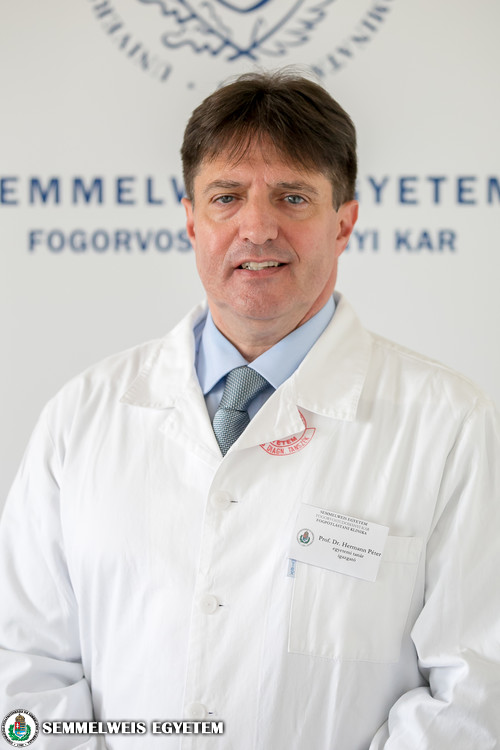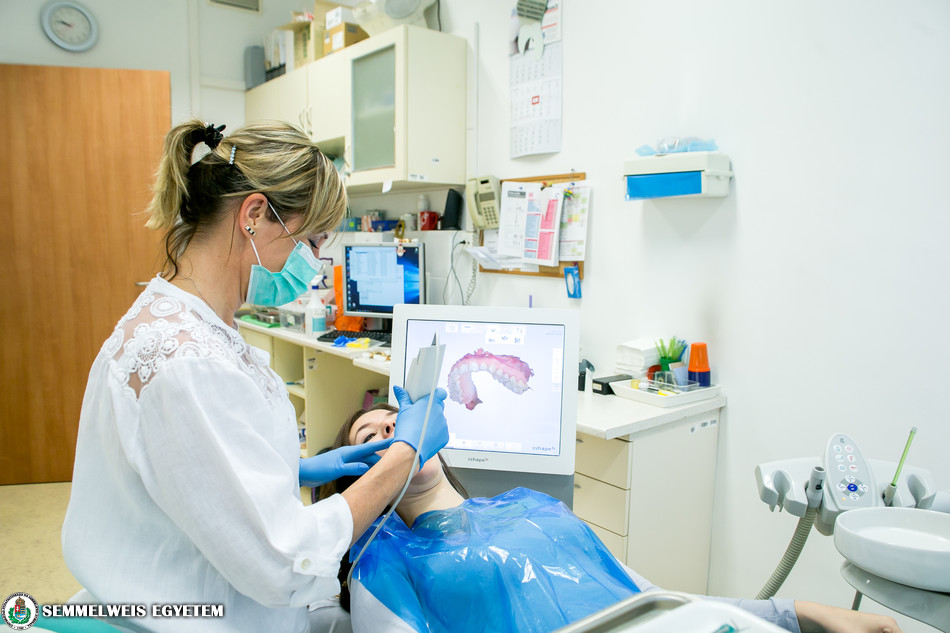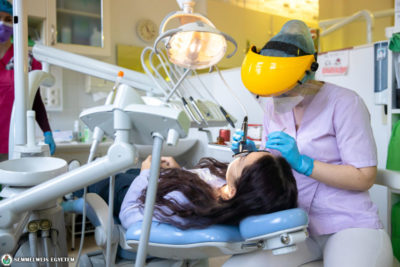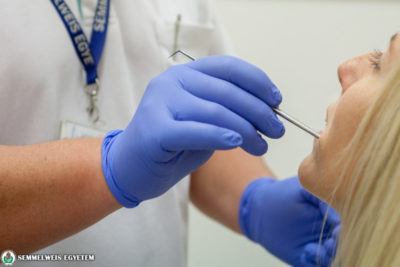On the fourth lecture of the online spring semester of 2021 dr. Péter Hermann (Vice-Rector for Educational Affairs, Head of the Department of Prosthodontics, professor) held a presentation about the latest digital technology of dental fittings. During the lecture he presented the operation of the intraoral scanner and showed how modern methods have changed the work of dentists.
 Dr. Péter Hermann pointed out that it is inevitable that digital technology will replace analogue methods in the field of dentistry and dental fittings. In his presentation titled “Increased use of digital technology during making of dental fittings” dr. Hermann (Vice-Rector for Educational Effairs, Director and Professor of the Department of Prosthodontics) showed the traditional way of making dental fittings and how the latest technology has changed this process over the years. In the past we took analogue impressions of the jawbone (which is a negative imprint). Then gypsum was poured in this to produce a dental replica. Later on a wax pattern of the dental fittings were put on the replica. This was followed by another pouring, resulting in a metal frame which was later concealed by using ceramics. The vice rector added that modern dental impressions can be made in a digital way -using an intraoral scanner. The data is then transferred to computers in the laboratory, where a special machine makes dental crowns using milling. Before applying the dental fitting, the final step requires manual precision.
Dr. Péter Hermann pointed out that it is inevitable that digital technology will replace analogue methods in the field of dentistry and dental fittings. In his presentation titled “Increased use of digital technology during making of dental fittings” dr. Hermann (Vice-Rector for Educational Effairs, Director and Professor of the Department of Prosthodontics) showed the traditional way of making dental fittings and how the latest technology has changed this process over the years. In the past we took analogue impressions of the jawbone (which is a negative imprint). Then gypsum was poured in this to produce a dental replica. Later on a wax pattern of the dental fittings were put on the replica. This was followed by another pouring, resulting in a metal frame which was later concealed by using ceramics. The vice rector added that modern dental impressions can be made in a digital way -using an intraoral scanner. The data is then transferred to computers in the laboratory, where a special machine makes dental crowns using milling. Before applying the dental fitting, the final step requires manual precision.
In the past few years a question has been raised among dental technicians: Will their work be needed in the future or machines will take over the industry. Actually, there is no reason to be afraid, Steve Jobs once said: Technology alone is not enough, someone needs to make the system work.
Dr. Péter Hermann also added that earlier dental technicians had to learn the technique of dental casting, nowadays they have to acquire other sorts of knowledge concerning dental fittings. The Department of Prosthodontics is striving to help dentists: 13 intraoral scanners have been tested between 2019 and 2021, giving a guidance to colleagues on how to choose the most suitable machine. The vice rector drew special attention to the fact that digital technology is much safer during the current epidemiological situation, as large part of the information is transmitted online, it requires less physical contact than the traditional, analogue methods.
Dr. Péter Hermann introduced the tools and materials used in new dental fitting procedures. He also mentioned 3D printers: printed materials are not precise enough, as they have different physical features and colours than the traditionally made materials. Therefore they can not be used as the final product of dental fitting. However, this technique can be applied for producing temporary dental fittings and it can replace gypsum to produce dental patterns.

The use of digital technology has become more common in the field of implantology- said the vice rector. He also added that thanks to the study of dental materials and technological development, materials can be used for more different purposes than before. Zirconium dioxide was used before as a substitute for the steel frame, however nowadays due to developed milling techniques the whole occlusal surface and the crown can be made of it. Dr. Péter Hermann also pointed out that doctors should choose the most advantageous and least invasive dental fitting procedure for each patient.
He mentioned the importance of choosing the right tooth color. Take a brilliant the dentist and a dental technician, who makes the dental fitting according to his best knowledge. If the color doesn’t comply with the patient and the dental fitting’s surrounding, we can be sure that the patient will not be satisfied. This emphasizes the subjectivity of colour vision and perception.
Digital dentistry requires the knowledge of different areas (such as computer science, physics, mathematics) that are not closely related to dentistry. The next generation of dental fitting professionals will have to acquire these, said dr. Péter Hermann adding that Semmelweis University and Neumann János University plan to start a B.Sc. programme in Digital dental planning. Students will be able to acquire the basics of these areas during the course.
At the conclusion of the presentation the vice rector illustrated dental fitting methods and techniques using practical examples, which had been previously mentioned in his presentation.
1982 Dr. Péter Hermann was accepted into the Faculty of Dentistry of Semmelweis University
1987 He was awarded the Madzsar József price as a 5th year student. In the same year he graduated summa cum laude and was granted the award ‘First Grade Outstanding Dentistry Student’
1987 Since his graduation he has been working at the Department of Prosthodontics of the Faculty of Dentistry, Semmelweis University.
1987 His first publication won first price in the Varga István competition and received a Körmöczi price in 1995.
1989 Acquired board certification in Oral stomatology with grade A.
1989 He was appointed Assistant Lecturer (assistant professor in 2000, associate professor in 2007)
2001 Deputy head of department (2007- Vice director, 2010- Head of Department of Prosthodontics) Participates in the English and Hungarian language academic teaching of dentist students
He has been holding lectures since several years and has been helping graduating students as thesis advisor. Joined the activities of the Department of Prosthodontics as a clinician.
He is involved in the further research of gnathology and the diseases of the temporomandibular joint.
1994 Spent three months at the Department of Prosthodontics of University of Leuven under the Tempus programme
1995 Studied periopathogenic bacterial culture at the Oral Microbiology Research Group of Department of Periodontology, University of Münster,
2004 Defended his Ph.D. thesis on Oropharyngeal candidiasis of immunocompromised patients
2004 Acquired board certification in Conservative Dentistry and Prosthodontics and a board certification in Periodontology with excellent results.
2005 Professor and lecturer of the subject Gnathology both in English and Hungarian courses. Member of the Faculty Council –Semmelweis University
1998 Secretary –Dental Section of the Hungarian Medical Chamber
2002 Vice – President –Dental Section of the Hungarian Medical Chamber
2007 – 2019 President –Dental Section of the Hungarian Medical Chamber
2001-2005 – Leader Member –Hungarian Dentist Associaton, Hungarian Association of Prosthodontics
1994 Editor of Hungarian Dental Journal (Magyar Fogorvos)
2003 Editor of Chief in Hungarian Dental News (Dental Hírek)
2005 Editor of Fogorvosi Szemle (scientific journal of the Hungarian Dental Association)
2008 Editorial Board Member of „Semmelweis Newspaper”
2015 Associate of Editors-in-Chief (Stomatology Edu Journal)
2005-2007 Expert responsible for medical technology at the Educational Centre of Semmelweis University
2012 Consultant to the vice rector
2007 Acquired a M.Sc. Healthcare Manager degree at the Health Services Management Training Centre of Semmelweis University
2006, 2007, 2010 and 2011 President of the National Committee of the Hungarian Dentistry
2007 – 2010 Vice – Dean –Semmelweis University, Faculty of Dentistry
2013 – 2015 Dean –Semmelweis University, Faculty of Dentistry
2009 Member of the Council of the Professional Association of Dental and Oral Diseases
2010 Habilitation –Semmelweis University
2010 Director of Faculty of Dentistry, Department of Prosthodontics
2011 Appointed university Professor
2015.01. Member of the Habilitation Committee of Semmelweis University
2015.07. Member of the Hungarian Academy of Sciences, Department of Medical Sciences, Clinical Scientific Committee
2015.07.01. Representative of the Faculty of Dentistry in the Executive Committee of the Clinical Centre of Semmelweis University
2015 Vice – Rector for Educational Affairs – Semmelweis University
2020 President of the Council of the Professional Association of Dental and Oral Diseases
To commemorate the 250-year-old anniversary, Semmelweis University launched a free series of lectures with the professional guidance of dr. Zoltán Nagy (professor emeritus) targeting an elderly audience and their family members. The lectures are held online during the current epidemiological situation. Participants can gain an insight into the latest results of medical science with the help of the university’s leading professors. The lectures also aim to showcase the most common diseases, their prevention, detection and therapy.
Ádám Szabó
Photo: Attila Kovács – Semmelweis University (illustration)
Translation: Norbert Lukács


